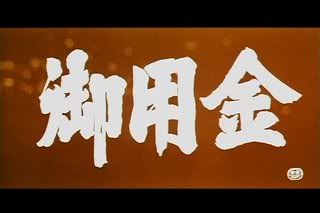
The samurai known as Magobei is an intimidating figure. From his very introduction, we can immediately deduce that he is intense, mysterious, and (of course) a master swordsmen. Played by the always-excellent Tatsuya Nakadai, Magobei is one of those samurai characters--like Wakayama’s Ogami Itto or Mifune’s Sanjuro--who, once seen, comes to epitomize the very figure of the samurai in film. Hideo Gosha’s Goyokin relies on his strong central performance, and Nakadai doesn’t disappoint, resulting in one of the more fun and exciting action movies of the 60s.
Hideo Gosha (1929-1992) was primarily a genre director, and this genre was action. He was a hell of a stylist, with a real eye for composition, and an obvious talent for filming action sequences. You could compare him to Kenji Misumi, since they seem to share a love of bloodshed, and since both produce highly stylized works, but where Misumi seems to bring out the inner comic book of his films, Gosha seems better at producing strong action scenes in a more realistic context. Most of Gosha’s films from the 60s are concerned with samurai, while his work from the 70s onward turns towards the yakuza.
Director Gosha and actor Nakadai had a long and fruitful partnership. While it’s a fairly common conceit to compare the relationship (and talent) of Akira Kurosawa and Toshiro Mifune to John Ford and John Wayne, one might also make a similar comparison between the duo of Gosha and Nakadai to the team of Sergio Leone and Clint Eastwood. Nakadai brings some real acting chops to Gosha’s movies, which helps to compliment Gosha’s professionalism as a filmmaker.
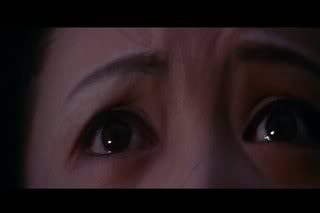
The plot of Goyokin only comes to the surface slowly. Magobei’s brother-in-law, Tatewaki (Tetsuro Tamba), is the head of the Sabai Clan, of which Magobei was also a vassal. Long ago, when Japan’s version of “the ship of gold” sunk just outside of a small village, Tatewaki came up with a fiendish plan: by taking the gold, he could replenish the coffers of the impoverished Sabai Clan, and the Shogunate would only need to know that the ship has sunk, its treasure lost. The problem, though, is that the inhabitants of that small village would be witnesses. So Tatewaki did what all samurai do best: he killed them all. Since the true perpetrators of the slaughter are never known to the general population, a legend develops, spreading the idea that the deaths were somehow the result of evil spirits or witchcraft.
Magobei was understandably upset by the slaughter. Out of loyalty to the Sabai, he agreed to stay quiet, since the truth would destroy them, but, unable to live with the murderers, he quit the clan and became a wondering ronin.
When the movie begins, the Sabai are once again in dire straights, and Tatewaki concocts a scheme to intentionally sink the next ship bearing ‘goyokin’ (official gold) and, once again, kill all the witnesses. Fearing that Magobei will find out about the scheme and attempt to stop it, one of the Sabai samurai sends off a couple of killers to get rid of Magobei before he can become a nuisance. Of course, they fail, and Magobei, now wise to the scheme, sets off to Sabai, to stop Tatewaki before he can kill again.
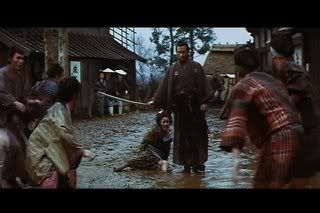
Goyokin is a strong movie in all regards, but it succeeds as well as it does because of Nakadai’s performance in the leading role. His Magobei is absolutely driven, and almost entirely devoid of emotion. It helps, too, that Gosha is able to craft some exciting action scenes for him, and Nakadai is up to the challenge, nearly as good at the physical stuff as he is in the rest of his performance. Luckily, though, his character is backed-up by fine performances from Tanba, Kinnosuke Nakamura (who plays a maniacal swordsmen with mysterious motives) and Ruriko Asaoka, who plays Oriha, the only villager to survive the original slaughter.
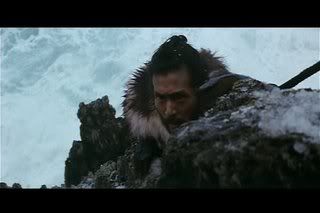
Like many of the samurai films of the late 60s and 70s, Goyokin presents a very calloused view of the samurai way of life. The Sabai, who are not shown to be atypical samurai, are hypocrites who truly care nothing about honour, and certainly not the common people below them. Magobei, a ronin, can hardly be counted as an answer to them; far from being an ideal samurai, he has turned his back on bushido. He may be out to help the next of Tatewaki’s victims, but it’s obvious that his personal vendetta is the true driving force.
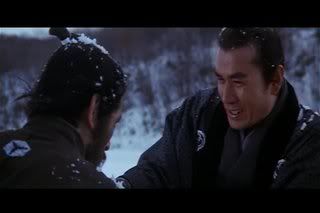
Perhaps it’s best to call Goyokin an adventure movie. Magobei’s journey involves a battle between samurai and yakuza, an escape from a burning building, cliff-climbing, and a silent duel on a snowy plain. Gosha doesn’t really allow for a dull moment, while at the same time managing enough down time for the characters to be suitably developed. A lot of credit should go to Gosha’s writing partner, Kei Tasaka, since many of Gosha’s other films lack such an even mix of character and action.
Goyokin is available in North America from Media Blaster’s “Tokyo Shock” label, and in Europe (French only) from Wild Side. The Tokyo Shock DVD is a decent release, about on par with the Animeigo releases of Lone Wolf and Cub. I know that Wild Side has some pretty tip-top releases, so I’d be willing to bet that that’s the better option for anyone who can read French. Everyone else need not worry, though, because the Tokyo Shock DVD really has everything you need.










No comments:
Post a Comment